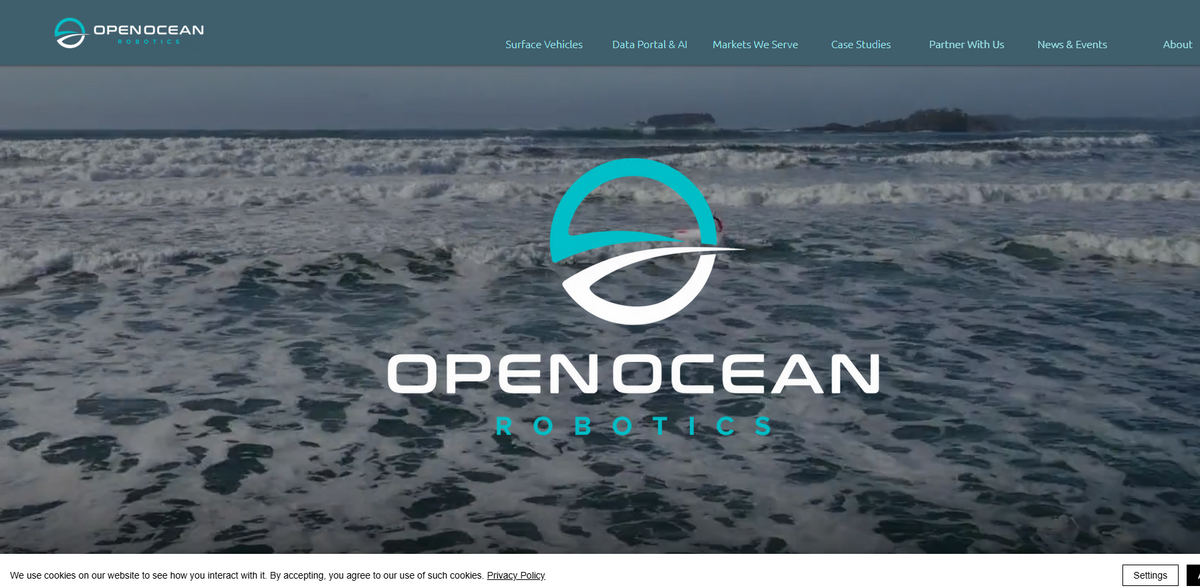What the Project Is
Open Ocean Robotics offers safer, more affordable, and sustainable ways to collect and manage oceanographic and maritime data. Their autonomous robotic data collection platform and cloud-based software system provide real-time data acquisition with AI-driven analytics. DataXplorer™ is a solar-powered uncrewed surface vehicle (USV) with innovative patented technologies, offering persistent emission-free ocean data acquisition even in extreme sea states. Paired with XplorerView™, a secure cloud-based data management and USV control system, this approach creates a whole new way to understand and protect our oceans. DataXplorer™ is a solar-powered ocean drone, also known as an uncrewed surface vehicle (USV). It remains on the ocean for extended periods by harnessing the power of the sun, collecting ocean and environmental data using its state-of-the-art suite of sensors. Capable of traveling in both coastal and open-ocean waters, and boasting a customizable platform for multiple sensor integration, DataXplorer™ helps researchers and industries see our oceans in a whole new way…
Main Benefit
Key figures and facts emphasize the breakthrough benefits of this technology:
- Solar-powered USV capable of extended missions at sea.
- Patented self-righting system — the USV can recover quickly, even after capsizing in storms or surf breaks.
- Zero-emission operation, eliminating greenhouse gases, noise pollution, and the risk of oil spills.
- Real-time data transmission via satellite, cellular, and radio communications for robust over-the-horizon operations.
- Energy-efficient systems and a streamlined hull maximize performance while minimizing power consumption.
Technology and Innovation
DataXplorer™ is powered by solar energy, making it unique in its ability to operate continuously on the ocean. It collects detailed oceanic and environmental information using an arsenal of advanced sensors and cameras. The innovative design includes a direct-drive motor and acoustic dampening at sensor mounts for quiet operations, ensuring superior data collection without interference. With its built-in edge processing, DataXplorer™ transmits actionable insights as they are collected, blending cutting-edge technology with reliability. The cloud-based XplorerView™ portal enables a secure and user-friendly interface for real-time USV operation and data viewing. It is a brilliant example of merging hardware ingenuity with software excellence.
Versatility in Data Collection
DataXplorer™ finds applications across various sectors, from research and environmental monitoring to offshore energy and maritime domain awareness. It can precisely be controlled to follow a desired route, conduct grid surveys, or even loiter in place when necessary. This flexibility ensures that data gathered meets the specific needs of government agencies, research organizations, and offshore industries. Its ability to operate in both shallow waters and challenging offshore seas makes it an ideal tool for comprehensive ocean data collection. The USV is designed not only to navigate coastlines and open waters, but also to endure extreme weather conditions. With its high-performance solar power system, DataXplorer™ can travel for months, recharging at sea and continuously collecting data, which in turn transforms how the marine environment is studied and protected.
Efficient and Eco-Friendly Operation
The efficient design of these solar-powered autonomous boats cuts operating costs dramatically—no expensive fuels, no noise pollution, and definitely no risk of oil spills. DataXplorer™ operates quietly, providing unintrusive yet exceptional monitoring of maritime activities. Its patented self-righting system ensures that even when nature takes an unexpected turn, the USV can recover and continue its mission. This energy-harvesting device translates into a safer, more effective, and affordable method of gathering comprehensive ocean data. The technology continues to evolve and push boundaries with its energy-efficient systems and streamlined shape that balance performance with sustainability. This is truly a dynamic solution for modern challenges in ocean monitoring…
Advanced Deployment and Communication
Deployment of DataXplorer™ is remarkably straightforward. The USV can be launched from a boat ramp or a ship, autonomously transiting to its designated operation site along the coast or offshore. Once its mission is complete, the vessel pilots itself back for retrieval—a seamless process that minimizes human intervention and operational risks. With integrated satellite, cellular, and radio communication systems, DataXplorer™ ensures robust and continuous real-time data transmission. The incorporation of edge processing means that even while at sea, high-resolution data is processed and delivered instantly, offering actionable insights when they are needed most. The dynamic use of these communication channels enhances maritime situational awareness, providing critical information for security, safety, economic, and environmental purposes.
Project Impact on SDGs
- SDG 7: Affordable and Clean Energy
- SDG 9: Industry, Innovation, and Infrastructure
- SDG 13: Climate Action
- SDG 14: Life Below Water
Future of Ocean Monitoring
Looking toward the future, the technology developed by Open Ocean Robotics is transforming the landscape of ocean data collection. By utilizing solar energy and AI-driven analytics, these autonomous USVs provide uninterrupted, detailed insights into our oceans. This innovation not only furthers the understanding of marine environments but also contributes to improved safety, security, and environmental stewardship. The autonomous boats — capable of traveling non-stop for months while recharging at sea — set a new benchmark for sustainability and efficiency in maritime data collection. This evolution in ocean research represents a smarter, cleaner, and far more cost-effective approach to understanding and protecting our oceans. The dynamic interplay between advanced sensor integration, real-time communications, and cloud data management ensures that the world’s oceans are monitored in a way that truly meets the demands of modern scientific and environmental endeavors…





















